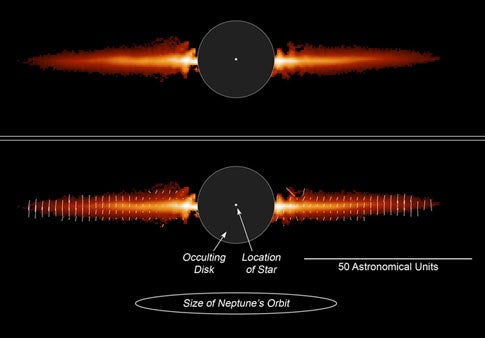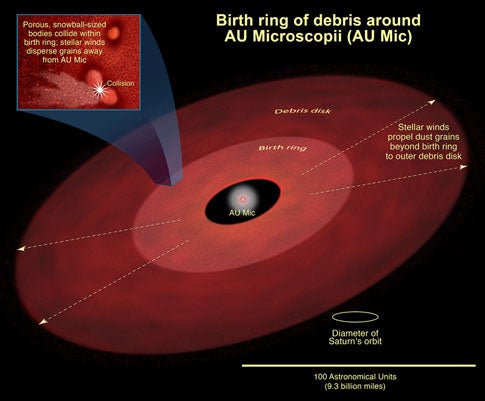New observations from NASA’s Hubble Space Telescope have begun to fill gaps in the early stages of planet birth.
Hubble observed a “blizzard” of particles in a disk around a young star revealing the process by which planets grow from tiny dust grains. The particles are as fluffy as snowflakes and are roughly ten times larger than typical interstellar dust grains. They were detected in a disk encircling the 12-million-year-old star AU Microscopii. The star is 32 light-years away in the southern constellation of Microscopium, the Microscope.
The particles’ fluffiness suggests that they were shed by much larger, but unseen snowball-sized objects that had gently collided with each other. These unseen objects are believed to reside in a region dubbed the “birth ring,” first hypothesized in 2005 by Berkeley astronomers Linda Strubbe and Eugene Chiang. The ring is between 3.7 billion and 4.6 billion miles from the star. As the larger objects bump into each other, they release fluffy particles that are propelled outward by the intense pressure from starlight.
“We have seen many seeds of planets and we have seen many planets, but how they go from one to the other is a mystery,” said astronomer James Graham of the University of California at Berkeley and leader of the Hubble observations. “These observations begin to help us fill in that gap.”
Graham and his colleagues, who include Paul Kalas of the University of California at Berkeley and Brenda Matthews of the Herzberg Institute of Astrophysics in Victoria, B.C., presented their results January 7 at the American Astronomical Association meeting in Seattle, Wash.
The astronomers used the Advanced Camera for Survey’s coronagraph and polarizing filters to analyze the starlight reflecting off the debris disk. The coronagraph blocked out the bright light from the star so astronomers saw only the reflected light from the nearly edge-on debris disk.
The polarizing filters allowed astronomers to study how dust is reflecting starlight. Dust in our atmosphere reflects sunlight so that only light waves vibrating at a certain angle are reflected toward us. Polarizing sunglasses take advantage of this effect to block out all reflections except those that align to the polarizing filter material.
Hubble is well-suited to make these observations because of its sharpness and its ability to precisely analyze polarized light without it being degraded by Earth’s atmosphere. The disk observed by Hubble formed later in the star’s life from debris shed through the collisions of small bodies. The bodies grew from dust in the primeval disk that encircled the newborn star.
Graham and his colleagues were surprised that fluffy particles could even form in a disk. “Circumstellar disks are thought to be vigorous, turbulent places,” he explained. “It is hard to understand why fluffy particles could grow and survive under such circumstances. But maybe there are some backwater places where turbulence had subsided and porous particles can form and grow. Planet-forming disks are undoubtedly much more complex than we currently envision.”
The evidence Hubble captured of events in AU Microscopii’s debris disk may parallel developments in our early solar system. “If we ran our solar system clock back nearly 4.5 billion years, then the infant Kuiper Belt would probably look like AU Microscopii’s birth ring,” said Kalas, an adjunct professor of astronomy at Berkeley. The Kuiper Belt is a reservoir of leftover icy material from the birth of our solar system.
The planets in our solar system lie inside the Kuiper Belt. Likewise, inside AU Microscopii’s version of the Kuiper Belt is a gap that may have been carved out by one or more as-yet unseen planets.
AU Microscopii is a red dwarf, the most common star in our Milky Way Galaxy. It is the perfect laboratory, therefore, for studying how planets form around everyday stars. Red dwarfs are fainter, cooler, and less massive than the Sun.











